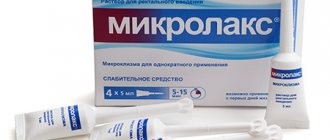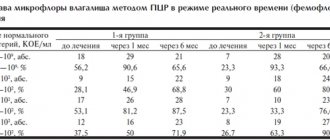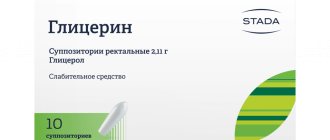Pharmacodynamics and pharmacokinetics
Glycerol ( glycerol ) is an osmotically active substance that increases excessive hydrostatic pressure. In medical practice, such properties of this compound are used to facilitate the transition of fluid from the extravascular bed to the blood serum.
When used parenterally and orally at a dosage of 1-2 grams per kilogram of body weight, glycerol, due to its dehydrating effect (increasing plasma osmolarity), helps reduce intracranial and intraocular pressure. In these cases, how quickly glycerin acts and how long it takes to act in adult patients depends on the direction of its use.
Maximum effectiveness when using the drug to reduce intracranial pressure is observed within 1-1.5 hours after its use. The onset of action to reduce intraocular pressure is observed after 10 minutes, maximum effectiveness develops after 1-1.5 hours, duration of action is about 5 hours.
Glycerol is used for dehydration therapy, indicated for cerebral edema , which occurred due to various reasons (including cases of acute poisoning), on the eve of or after ophthalmic surgery (to reduce intraocular pressure), as well as to relieve negative symptoms of an acute attack of glaucoma .
As an external remedy, Glycerin is useful for its dermatoprotective and softening qualities, as well as pronounced lubricating and hygroscopic properties. When applied to the skin, metabolic processes are activated in it, and a protective film is formed on its surface.
In pharmaceutical practice, glycerol is often used to make an emollient ointment or cream for hands and/or feet. Quite popular in cosmetology are an anti-wrinkle face mask and a hair mask, as well as glycerin soap and glycerin oil with the addition of vitamins and other useful ingredients. However, you should avoid frequent use of glycerin oil and glycerin soap, the benefits and harms of which, especially for people with oily skin, may not be as expected (excessive skin whitening and acne ).
Glycerin rectal suppositories are a laxative remedy designed to soften previously hardened fecal matter, which leads to easier passage through the lumen of the colon. Also, this local drug is characterized by an irritant effect on the intestinal mucosa and reflex stimulation of the motility of the lower gastrointestinal tract.
When used rectally, glycerol undergoes fairly rapid resorption in the intestinal mucous membranes. How long it takes for glycerin suppositories to take effect depends on the individual characteristics of the human body; on average, the laxative effect develops within 15-30 minutes. The main biotransformation of the active ingredient occurs in the liver. Excretion is carried out by the kidneys (7-14% of glycerol is excreted in unchanged form).
How to use glycerin suppositories
The product is used rectally. After inserting the suppository into the rectum, it is advisable to lie down for at least 10 minutes so that the melted suppository does not leak out.
Application schemes:
- adult patients and children over 7 years old - one suppository with a dosage of 2.11 g once every 24 hours;
- children 3-7 years old - one suppository with a dosage of 1.24 g no more than once a day;
- children under 3 years old – half a candle with a dosage of 1.24 g once.
If these doses are ineffective, they can be doubled.
Indications for use
As a therapeutic agent, the drug is indicated for use in cases of difficult bowel movements or its complete absence, in other words, these suppositories are prescribed to patients suffering from constipation of various origins (functional, age-related, psychogenic, etc.), including similar negative phenomena in nursing mothers and pregnant women .
As a prophylactic agent, the drug is used to prevent constipation in patients for whom physical stress is contraindicated, including that which occurs during the act of defecation: anorectal abscess , thrombosed painful hemorrhoids , anorectal stenosis , a history of anal fissures myocardial infarction and other similar painful condition.
Problems with stool in children
The main ones are increased frequency (or diarrhea) and difficulty (constipation). Among children under one year of age, every fifth person suffers from constipation; Among older children, constipation occurs in every sixth child.
95% of all constipation in children are functional, the remaining 5% are congenital features of the intestinal structure. In most babies (out of 95%), constipation is associated with external problems.
In children of the first year of life, Hirschsprung's disease (described by H. Hirschsprung, 1830-1916, Danish physician) is the most serious (one case in 2 - 5 thousand newborns), so let's talk about it briefly. The essence of the disease is that the nerve cells in one of the sections of the intestine are not developed, which means that this section functions incorrectly (is in a state of contraction) and feces accumulate in front of it. The reason is a violation of the development of embryonic tissue. Treatment of Hirschsprung's disease is only surgical. The purpose of the operation is to remove the non-functioning section of the intestine.
Functional constipation can have many causes
- Water deficiency in a child's diet. When the baby is only breastfed, he does not need supplemental feeding (breast milk contains everything he needs). But if the child eats an adapted milk formula or has started to eat complementary foods, liquids must be offered. According to general recommendations, only water should be used as additional fluid for an infant and 100-150 ml of water should be given daily.
- Deficiency of dietary fiber in the diet and excessively crushed food. For example, a child eats bread and various cereals, but refuses vegetable and fruit purees and does not want to eat food in pieces. As a result, feces form very slowly, become denser and defecation becomes more difficult - constipation occurs.
- Psychological problems. If parents potty train their child early and persistently, he may begin to resist the urge to defecate. After some time, the body stops sending signals to the brain about the need to poop. Feces accumulate in the rectum, stretch it and dry out, which in the future leads to painful bowel movements. If it hurts your baby to poop at least once, he will hold back even more.
- In children after 3 years of age, a similar situation may occur when they do not like the toilet (dirty and uncomfortable toilet, the child does not feel privacy, a strong smell, etc.) or the child tolerates it until he comes home. And at home he may forget that he needs to poop. A few days in this mode and you need to treat constipation.
- Food allergies. More often it is an allergy to cow's milk proteins and a reaction to other products. Rarely is constipation the only symptom of a food allergy; it may be accompanied by abdominal pain and/or skin rash. There may also be lactase deficiency with food allergies. With lactase deficiency, the baby does not have enough enzymes to digest milk, which may be accompanied by thinning of the stool, but in 10% of children it may result in constipation.
- Other causes of constipation: infections, metabolic disorders, lack of physical activity, digestive problems, taking iron supplements and much more.
You may be wondering, “Why is the birth of a child not always a joy?”
Contraindications
The use of Glycerin suppositories is prohibited when:
- pain in the abdomen of an uncertain nature;
- individual hypersensitivity;
- tumor formations of the rectum;
- renal failure;
- inflammatory pathologies of the rectum ( proctitis , paraproctitis );
- appendicitis;
- intestinal bleeding ;
- presence of anal fissures ;
- manifestations of diarrhea ;
- exacerbation of hemorrhoids .
Glycerin suppositories, instructions for use
Suppositories with glycerin are intended exclusively for rectal administration, which is best administered 15-20 minutes after a meal (usually breakfast).
Instructions for the use of glycerin suppositories for children over 7 years of age and adult patients involve the use of a dosage of 2.11 grams (1 adult suppository), administered once every 24 hours.
Instructions for use for newborns recommend using children's glycerin suppositories in a dose of 1.24 grams, with a single daily administration of ½ suppository for children under 3 years of age and a whole suppository for children 3-7 years of age.
Instructions for use during pregnancy correspond to the recommendations given for adult patients. Suppositories can be administered to pregnant women only after a comprehensive examination by a gynecologist and with his consent.
How long it takes for a glycerin suppository to take effect in an adult and a child depends on the dose and the individual response of the patient’s body to the effects of glycerol. As a rule, no more than 30 minutes pass from the moment the suppository is introduced until the act of defecation.
If absolutely necessary, adult and pediatric doses can be doubled.
Method of using rectal suppositories
- Before using glycerin suppositories, you must thoroughly wash your hands with soap, after which, in order to cool, it is advisable to hold them for some time under cold water. Since the base of rectal suppositories quickly melts upon contact with warm hands, in addition to cooling the hands, it is also recommended to cool the suppository itself by placing it in the refrigerator for a few minutes before using it or also holding it under cold water (do not remove the primary wrapper from the suppository follows), which will make it more durable.
- After the procedures described above, you must carefully remove the primary packaging from the candle, using a sharp object (knife, scissors) if necessary.
- If it is necessary to use ½ candle, cut it lengthwise into two equal parts using a disposable razor blade.
- The suppository removed from the wrapper should be taken with clean fingers or hands wearing disposable gloves.
- Lubricate the tip of the candle with a water-soluble lubricant (without Vaseline ) or moisten the anus with cool water.
- Take a lying position on your side with your lower leg fully straightened and your upper leg bent towards your stomach.
- Lift your upper buttock with your free hand, thereby opening the rectal area.
- Insert the suppository into the anus and insert it into the rectum using your fingertips beyond the muscular sphincter to a distance of approximately 2.5-5 cm in adults and 2.5 cm in infants.
- Bring your buttocks together and hold them in this state for several seconds.
- Remain in a side-lying position for 5 minutes, which will prevent the suppository from coming out.
- Throw away the used packaging and wash your hands thoroughly.
Why don't glycerin suppositories help?
Causes:
- In order to eliminate the cause of constipation, it is necessary to give the child lactobacilli, as well as completely change the diet, and introduce more fruits, vegetables, cereals, and possibly foods that stimulate bowel movements into the diet. Such as beets or prunes, along with dried apricots.
- Many parents ask whether it is possible to use glycerin suppositories intended for adults in children? It is possible, but you just need to follow the dosage. The fact is that adult suppositories contain more glycerol, while children's suppositories contain much less. Therefore, you may have to divide an adult candle into 2 or even 4 parts, depending on the age of the child.
Laxatives
Glycerin suppositories are an emergency drug that helps eliminate pain in the rectum from constipation. But suppositories do not treat bowel dysfunction. If you experience frequent constipation, we advise you to adjust your diet and consult a doctor.
special instructions
You should not resort to systematic use of this remedy. The use of suppositories should be discontinued immediately after restoration of typical physiological intestinal motility.
Do not lubricate candles or the anus with solid or liquid mineral oils .
Glycerin suppositories for hemorrhoids are indicated in case of complications of this disease with constipation , lasting for 2-3 days. The use of suppositories is contraindicated for hemorrhoids in the acute period ( bleeding , bowel prolapse , etc.).
After childbirth, glycerin suppositories can be used if there is no stool for 2-3 days. These recommendations are appropriate especially after childbirth with stitches, when hard stools or physical stress during defecation can damage their integrity. Suppositories can be used only after consultation with a gynecologist and in the absence of mechanical damage to the anus.
Analogs
Level 4 ATX code matches:
Norgalax
Glycerol
Microlax
- Dexeryl
- Norgalax
- Glycelax
- Normacol
- Enema
- Ready-Tu-Uz
- RectActive
Glycerin suppositories for newborns
The instructions for glycerin suppositories for newborns suggest their use from the first days of a child’s life. Glycerin suppositories for infants are usually indicated in a daily dosage equal to ½ suppository weighing 1.24 g, administered once every 24 hours (whether whole baby suppositories can be administered to newborns is decided by the pediatrician, based on the observed situation).
To properly administer the drug to newborns, you should first place the child on his back, bending his legs close to his tummy, and carefully, slowly insert a glycerin suppository (with the rounded end forward) as deep as possible behind the muscle sphincter. You can also lay the baby on his left side and bend his legs at the knees towards the tummy.
After this, you need to close the baby’s buttocks and hold them in this state for some time (about 2 minutes). This manipulation is carried out in order to prevent the suppository from slipping out and its immediate effect.
Reviews from pediatricians say that when the administration procedure is performed correctly, the laxative effect in infants occurs within 5-10 minutes.
Can glycerin suppositories be used for children?
Quite often, candles are prescribed for children. However, it is a symptomatic treatment for constipation and is not used very often. Pediatricians recommend using these suppositories no more than once every 3 days.
Features of use in children:
- If your child often experiences constipation, then it is necessary to take a comprehensive approach to treating the problem, rather than eliminating the symptoms. The fact is that glycerol, which is part of glycerin suppositories, irritates the intestinal receptors.
- Over time, their sensitivity may decrease, which will lead to the fact that the intestines will not work on their own. This medicine should not be abused. This is a kind of emergency help.
- Many parents begin to get nervous when, after defecation, the child does not calm down, but on the contrary becomes even more anxious and cries. This happens to infants. It’s not a matter of gas, intestines or constipation, but some other reasons.
Baby candles
Glycerin suppositories during pregnancy and lactation
The official instructions do not describe any restrictions on the use of the drug for constipation during breastfeeding and pregnancy , which, in principle, is confirmed by numerous reviews of women using this remedy during these periods.
However, some gynecologists do not recommend the use of glycerin suppositories during early pregnancy, since at this time the uterus is quite close to the rectum and the relaxing effect of the drug can also affect its tone. During late pregnancy, the above-described contraindications and the threat of miscarriage .
What are glycerin suppositories used for?
It is worth noting that the active component of this product is glycerol, it is not toxic.
Action and application features:
- It has an irritating effect on the intestinal walls, stimulating its work, as well as the excretion of feces. It has a softening effect on feces, helping to make it softer and, accordingly, simplify its removal from the intestines.
- It is often prescribed for rectal fissures, after myocardial infarction, as well as in patients who, for some reason, cannot strain during bowel movements.
- Please note that there are a number of contraindications to the use of these suppositories. They are irritating and can cause a number of unpleasant sensations. This type of suppository cannot be used for hemorrhoids, as well as for various tumors, polyps, or after surgical interventions.
- That is, it is not recommended to use these suppositories in cases where they can provoke the development or exacerbation of a chronic disease.
- Regarding the possibility of use during pregnancy and breastfeeding, it is quite possible to do this. Because very often pregnant women, due to the high concentration of progestins in the blood, experience constipation and difficulty removing feces from the body. Accordingly, such candles will become a salvation for pregnant women.
Candles
Reviews of Glycerin suppositories
The vast majority of reviews about this remedy for constipation, including reviews of glycerin suppositories for newborns, children and adult patients, are positive. A significant portion of people using this drug have experienced its rapid and relatively long-lasting effect in the absence of significant side effects and are completely satisfied with the results obtained.
Reviews of glycerin suppositories during pregnancy are not inferior in their positive assessment to the prevailing opinion and also position this drug as quite effective and inexpensive.
However, it should be remembered that the use of glycerin suppositories only facilitates the act of defecation and in no way affects the cause of constipation, which simply needs to be correctly diagnosed and effectively treated.
How often can you use a glycerin suppository?
It is advisable to use glycerin suppositories early in the morning, 15 minutes after breakfast. They act quite quickly, the maximum number of candles that should be used in one day is 1 or 2. That is, the maximum number is two candles, you should not use more. If even after using such a number of suppositories it was not possible to improve the condition of stool and stimulate bowel movements, we recommend using other drugs, in particular some drops for a laxative effect. This drug cannot be used on an ongoing basis.
If you experience constipation very often, along with rectal fissures and hemorrhoids, this is not the best drug to ease bowel movements. Because it has an irritating effect on the intestinal walls. This is a kind of first aid if nothing better is at hand. With frequent constipation, it is necessary to solve the nutritional situation. It is necessary to introduce a large amount of fiber into the food, as well as foods that will weaken and stimulate the act of bowel movement. In this case, it is not advisable to use candles.
Constipation
Price of Glycerin suppositories, where to buy
The average price of Glycerin suppositories in Russia is about 200 rubles.
In Ukraine, the price in pharmacies for Glycerin suppositories No. 10 is approximately 70 hryvnia.
- Online pharmacies in UkraineUkraine
Pharmacy24
- Farmina 1.5 g N5 suppositories glycerin suppositories Farmina Ltd., Poland
50 UAH. order








